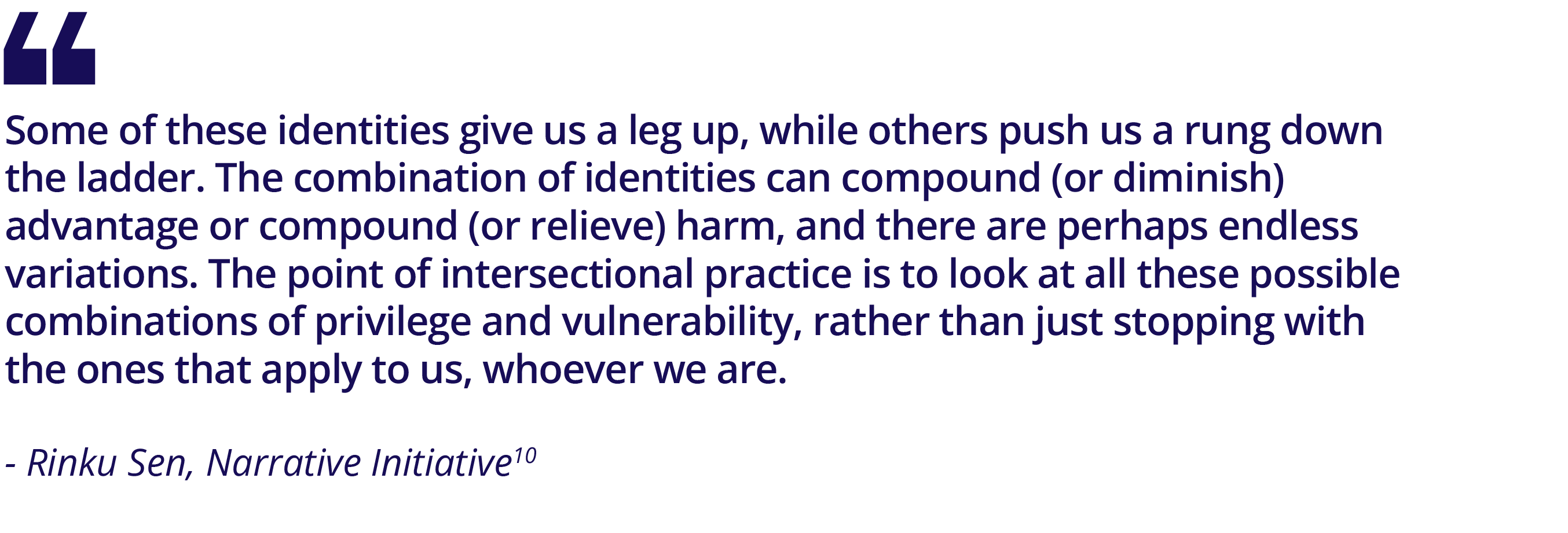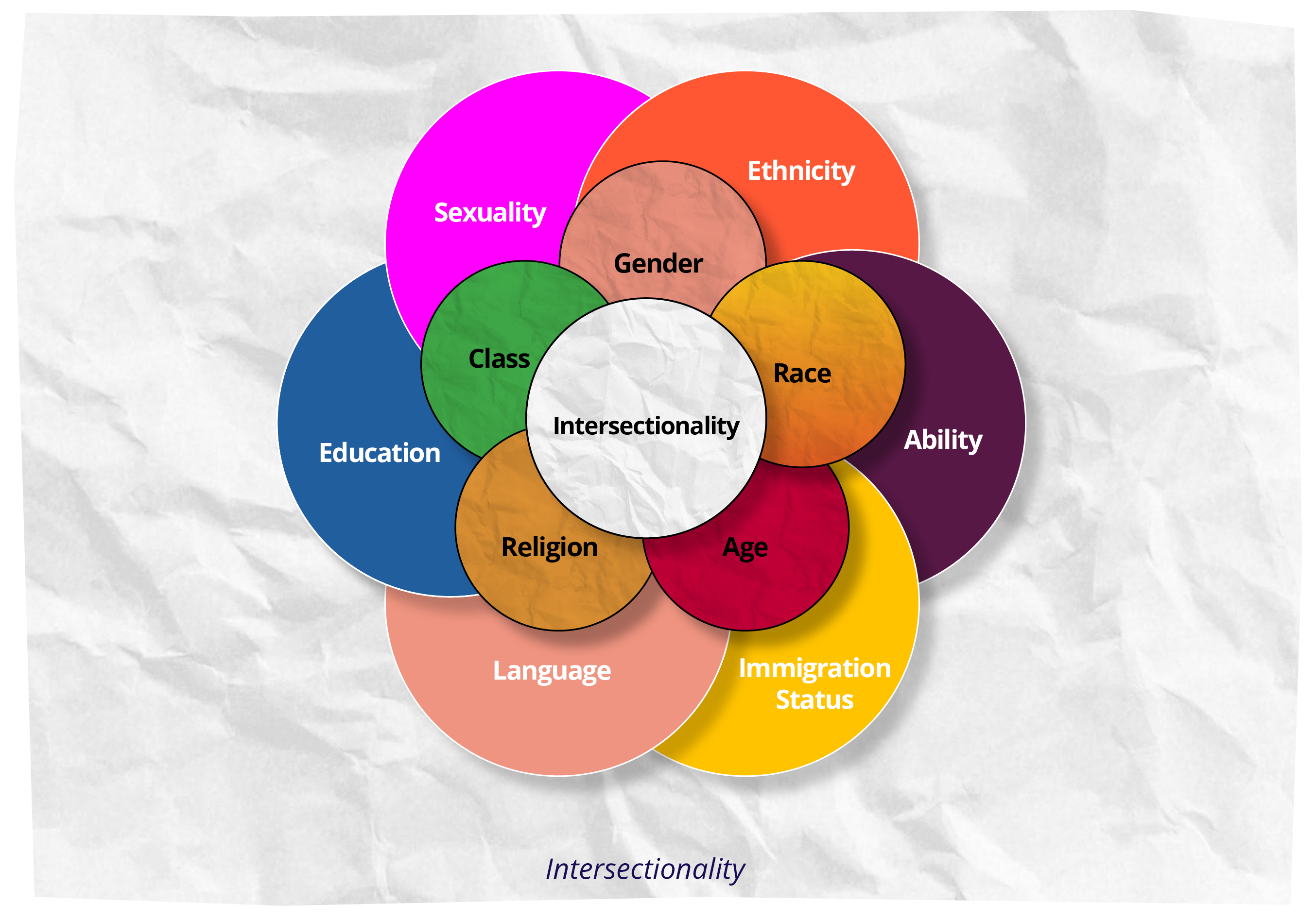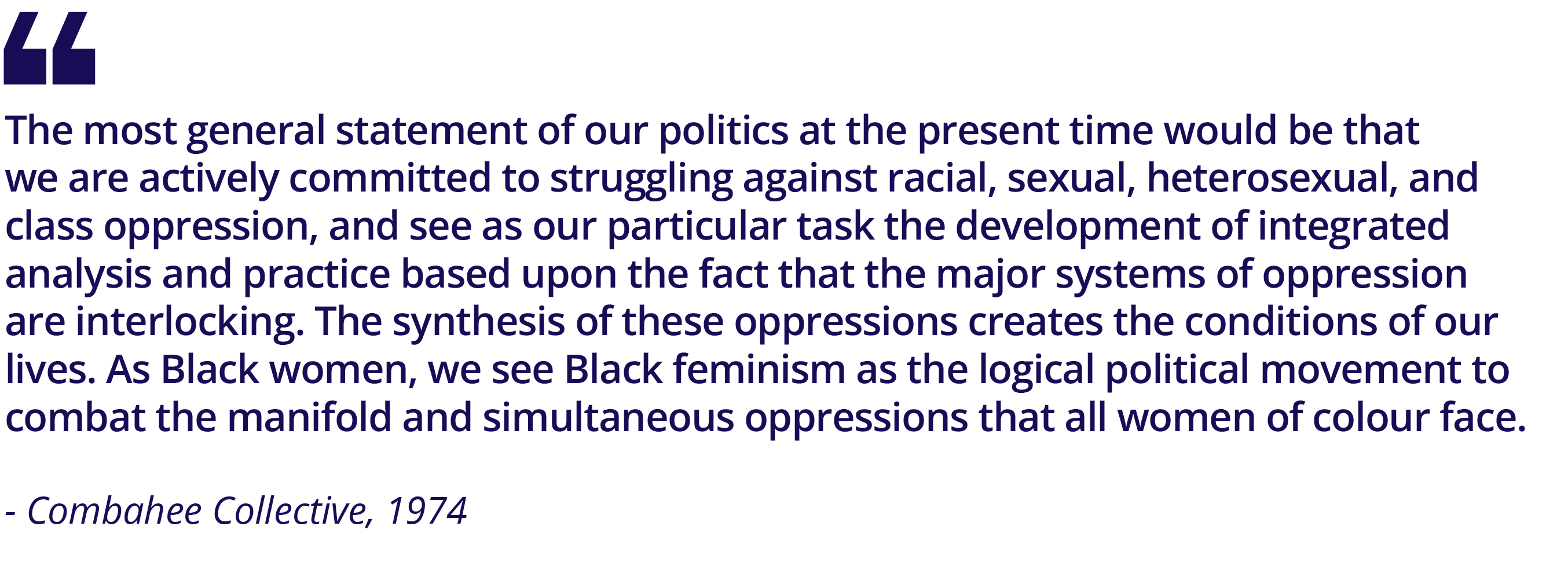Theme 4: Power and Interconnected Identities
A critical layer of unpacking and dismantling power over relates to our interconnected identities. Systems of privilege, inequity, and oppression are embedded in our institutions and reproduced by social norms and beliefs around gender, class, caste, race, sexuality, ethnicity, geography, age, ability, and other factors. Discrimination, oppression, and violence based on identities are socialised and institutionalised in all aspects of our lives. The intersection of these identities makes oppression or possibilities of transformation different for different people in different contexts. Our identities can also be a source of connection, power, joy, and transformation.

This section introduces identities and intersectionality as essential to both power analysis and power-building strategies. In the activities, we discuss the ways we experience our identities in the intimate, private, and public arenas of our lives. These dimensions of power are explored more deeply in Chapter 4: Identity, Intersectionality, and Power.
Activity 6: Identities, power, and privilege
Our personal experiences help us understand discrimination based on identity.
Materials: Flipchart paper, markers
Accounts of intersectionality: Video “Phumi Mtetwa (South Africa) – Walk Together in Struggle” and video “Dalila de Jesús Vásquez (Guatemala) – Transforming Oppression into Liberty”.
Handout: Intersectionality
Plenary: Set the tone for a safe, open discussion. Take time to define terms such as gender, class, and ethnicity so that participants are operating from similar understandings. You could refer to the JASS Feminist Movement Builder’s Dictionary. Ask:
- How do you understand discrimination and oppression in relation to gender, ethnicity/race, class, sexuality, and other factors of exclusion?
Small groups: In groups of three, watch the videos. For each one – Phumi Mthethwa and Dalila de Jesús Vasquez – discuss:
- What are the different social identities that shaped the storytellers’ experiences?
- In what ways were their identities a source of connection and power, and in what ways did they trigger structural discrimination and/or violence?
- What other observations about identity and intersectionality can you glean from these examples?
Plenary: Invite discussion. Ask a second facilitator or participant to write answers on flipcharts.
- What do we learn from Phumi and Dalila’s stories about identity and intersectionality?
- Do you relate to any parts of these stories? Are there moments in your life where you have experienced barriers or advantages due to your gender, race, class, sexuality, ability, age, immigration status, education, or other aspect of your identity? How did you become aware of how your identity affected you? Did you feel any discomfort or other emotion?
- Can you share experiences where awareness about your identity(ies) has been a source of power, connection, and belonging?
- Why is intersectionality important to our strategies and organising?
Download this activity.
Intersectionality

Like many terms that have become mainstream, intersectionality can be controversial, so it’s helpful to clarify what we mean by it. Defined in 1989 by Kimberlé Crenshaw, a Black legal scholar in the US, ‘intersectionality’ describes how race, gender, class, sexuality, and other characteristics intersect and overlap to create different experiences of oppression, discrimination, and privilege.
Activists of earlier generations note that intersectionality was a concept and practise long before it was introduced in legal studies. Indigenous peoples and Asian, African, and Latin American feminists of earlier generations, particularly those working in popular education, focused on interconnected forms of oppression.

Like many political ideas, intersectionality is contested by the right and the left. But a critical analysis of the intersections between our different identities is a core part of building individual and collective awareness and power. We come to recognise and celebrate the different and converging sources of our power as well as our oppression. This can inspire us to mobilise within and across our identities for change, find common ground, and create alliances.
Download handout: Intersectionality.
Activity 7: Intimate, private, and public realms of power
Here, we build on the ideas and practice of intersectionality and power analysis. Our experiences of power and identity vary and can even be contradictory in different realms of our lives, from our intimate relationships to the private realm to our public selves. These differences reveal a lot about the logic of systemic power and the force of invisible power – ideas, beliefs, and norms – in all aspects of our lives. Where we might feel confident in our public leadership and activism, we may be more cautious in our families, where challenging norms can create conflict and threaten our deepest relationships. Alternatively, we may feel confident in our personal lives, yet face conflicts and challenges in our organisations and public activism. This framework is important in understanding how change creates both personal and political conflict and helps us feel empathy for and deal with the challenging implications of organising and leadership.10
Materials: Handout: Intimate, private, and public realms of power
Copies of the matrix for each group
Flipchart and markers
Plenary: Share copies of the handout, or show the contents as slides, to introduce the topic.
Small groups: Each group chooses one aspect of identity to work on – such as gender, class, race, ethnicity, sexuality, age, ability, or faith. Each group reads the handout out loud. Using or adapting the matrix, discuss how each identity can be experienced differently in the intimate, private, and public realms of life. Prepare a flipchart or drawing to share in plenary.
Tool 3: Matrix for intimate, private, and public realms of power
Plenary: Post small groups’ flipcharts or drawings around the room or on the virtual space. Each group briefly presents their key points. Facilitate a wrap-up discussion, emphasising these key points:
- Dominant belief systems and systemic power establish hierarchies based on gender, race, class, and other identities. All institutions and beliefs are structured around these hierarchies. They assign value and create dynamics of privilege and exclusion that are both deeply personal and structural.
- Each of us is shaped by a mix (intersection) of identities, including gender, race/ethnicity, religion, class, sexuality, age, ability, education, and immigration status.
- Challenging the status quo can create conflicts in our organisations and personal lives, and these conflicts impact our wellbeing, leadership and activism. We must consider these tensions in our strategies and their implications for how we lead, work together, and support collective care.
- Intersectional analysis and organising are essential in ensuring that we build more inclusive democratic spaces and treat one another with grace. This takes time and courage to deal with the awkward realities of privilege and power as they play out in our lives.
- Our identities can also be a source of power, connection, belonging, and liberation – and many social movements have redefined how we see each other. Identity, like all forms of power, is dynamic and context-specific, although systemic power – patriarchy, capitalism, structural racism, and colonialism – continues to define the meaning of aspects of identity as it has over history.
Download this activity.
Intimate, private, and public realms of power
Because of the ways oppression operates, distinct aspects of our identity can create contradictions and conflicts in the different realms of our lives. We may behave or be treated one way in our public life, but another way in our private or intimate lives. Leadership and organising strategies need to take this into account to support deeper transformation. As the well-known feminist adage says: “the personal is political.”
The intimate realm of power: my sense of self, personal confidence, psychological well-being, and safety and my relationship to (and control over) my body and health
The private realm of power: my relationships and roles in the family, among friends, in sexual partnerships and marriage, and so on
The public realm of power: how I am seen and treated in my public life, such as in my organisation, employment and community, including my legal and civil rights
For an individual, the experience of power and powerlessness differs based on gender, sexuality, race, class, or age, and may even be contradictory in different realms of life. For example, a woman politician who appears confident in public may accept a subordinate role in her family; she may even survive abuse in her private relationships while keeping up with the demands and image of her public duties. Throughout the world, it is common for a woman to face the same work demands as her male partner and yet be primarily or solely responsible for the maintenance of the home and children. Similar conflicts and contradictions can be true of, for example, a Black man, a gender non-conforming person, or someone differently abled: they face a dominant culture that is discriminatory that they must find ways to navigate but have a very different experience in their private or intimate life.
It is helpful to acknowledge these layers and contradictions in order to understand the tensions that are generated by our political organising and change work, particularly for those who experience sexism, racism, classism, or ageism more directly. Political change and advocacy strategies that focus solely on the public realm may overlook challenges such as those faced by women leaders, activists, and public officials when they return to their homes and families.
Download handout: Intimate, private and public realms of power.
____________________________________
10 https://narrativeinitiative.org/blog/how-to-do-intersectionality/
11 Adapted from Lisa VeneKlasen with Valerie Miller, (2002), A New Weave of Power, People & Politics: The Action Guide for Advocacy and Citizen Participation, Practical Action Publishing, and originally conceptualised by Nicaraguan feminist activist and scholar, Malena de Montis.
